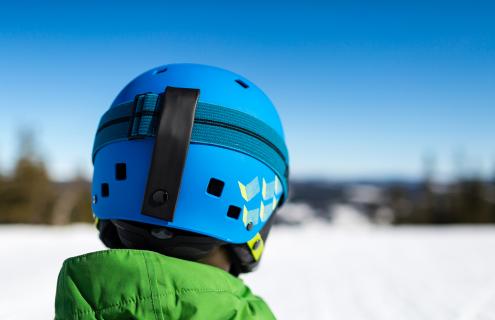
Sledding, skiing, skating, and neighborhood snowball fights may be Monadnock Region family favorites this time of year, but it is important to protect yourself and those you love so a serious brain injury doesn’t spoil your fun. More than 170,000 kids and teens are treated in emergency room departments each year for sports or recreation-related traumatic brain injuries, including concussions. Both kids and adults’ lives can change in an instant from a bump to the head.
Which helmet should I choose?
While there is no concussion-proof helmet, a helmet can help protect you from a serious brain or head injury. The U.S. Consumer Product Safety Commission (CPSC) and The American Academy of Pediatrics both recommend you wear a protective helmet for any winter sport, but different helmets are appropriate for different activities.
Ice is easy
You probably already own a bike helmet—a multi-sport helmet like this is good for ice skating, sledding, or playing hockey—unless you’re the goalie, then you do need a full face mask helmet, preferably one that is ASTM-certified (American Society for Testing Materials).
Slopes are more serious
The high speeds possible while skiing or snowboarding, along with the increased likelihood that you may run into a tree, ledge, or most often collide with another person, means that a multi-sport helmet is not enough protection.
Choose a helmet that is ASTM-certified for skiing and snowboarding. Important qualities of ski helmets include:
- Greater thickness than a multi-sport helmet and better for absorbing collision impacts.
- Thickness that keeps your head warmer at higher altitudes and for longer periods of time.
- Design that allows for an appropriate fit of ski goggles. Goggles protect your eyes from the sun’s harmful rays and flying debris, are vented to prevent fogging up, and can improve vision by reducing sun glare off the snow.
Is it the right fit?
- The straps should make a V shape under your ears once fastened.
- To make sure your helmet is not too far back or too far forward, the space between your eyebrows and the rim of the helmet should be one or two finger widths.
- You should be able to fit no more than one finger between the strap and your chin.
- The helmet shouldn’t be able to move more than one inch in any direction during a shake test once you’ve dialed in the perfect fit.
Know when to replace your helmet
- Most helmets made with an EPS (or expanded polystyrene) liner need replacing after just one crash. The tightly-packed air bubbles in EPS crunch down during impact to cushion your head, but don’t bounce back so it will not work more than once.
- If you wear it often, don’t use any helmet for more than five seasons, even if you’ve never crashed in it. EPS breaks down with sweat, hair product, and cleaning solution.
- Many helmets have a printed expiration date replace your helmet when that passes, if you haven’t already.